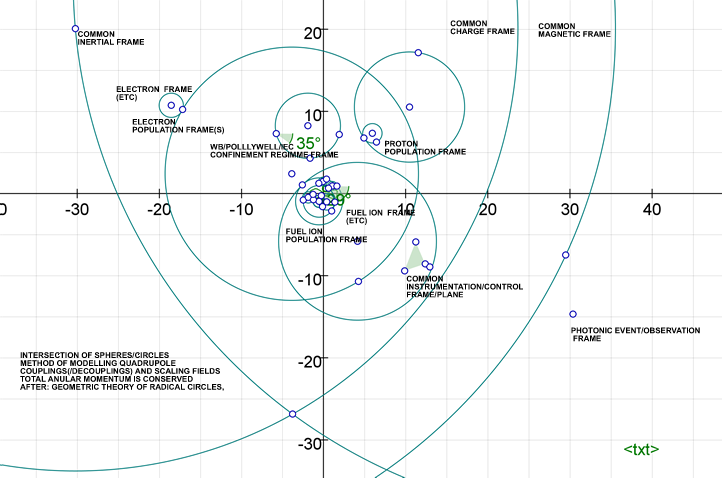have just produced a (coupled) frame ensemble model of (what i think is approximate map of wb regime). at this stage its just meant to represent a 'properly' coupled approximatoin to our regimes stable modes (poles and zero's), particles, populations, particle-population and particle-particle and poulation-pulation intersects (transitions/colisions), and a. simple turing machine running though complex harmonic motion(s) and reconnection/disconnection impulses.
it isnt complete yet. (i've used http://db-maths.nuxit.net/CaRMetal/index_en.html - which seems a simple but powerful java geometry modeller).
heres a quick pic of the approach/output snapshot, from geometric perspective.

ive uploaded a copy of the actual code here -
http://theknowledgecentre.co.uk/rcain/p ... al-app.zir - , if anyone would like a closer look. (theres also the vast database of intersecton transformaton sequences available at - http://www.uff.br/trianglecenters/etcwc.html . just a few primitives are sufficient for me right here - some intersects have harmonics, others not).
this picture came out of a desire to understand the other thread - cusps & (spacial, energy) distribution/density, ion and electron momenta under various stable and pulsed regimes/phases in cycles. this model uses only properties of triangles and circles and is (almost) cannonically correct so far i think, or could easily be made so.
the model allows us to do more than just proximity based collisions/transitions. it allows coupling characteristics to be defined at the appropriate electron-event intersections as well as meta-data (like the oberver frame and camera frame in scale. model is infinitely scalable/dimensionless..
i hoped it might be helpful in spotting order-of-magnitide gaps, and sensitivity/stability & required precision near regime modal stabilities..
intentionally missing from the attached snapshot image version are (loads of things) but mostly:
a) the long curved fast fusion products we want to fuse out of the ion population, intersecting ion/electron balance (sphere/plane) and eventually pumped to outside of the system as work. (we will asume this to lie more or less parallel to and inside our inertial-magnetic-eletric frame, but outside all other population shells, energy wise).
b) all inertial entities should actually be connected to the plane/circumference of the inertial plane, they only become disconnected when undergoing total entropy/fision/fusion.
c) there is a defined root frame known as root-mother (containing canonical taxonomy, cannonical tokens/dimensions/plank numbers). (assumed parallel the inertial frame intersect here).
d) each intersection between spheres can model elastic as well as inelastic collisions (), refractive index, intercept cone, and c if you want. .
e) even simple configurations have many solutions , but slightly more solutions are forbidden/undeclared. it is permissible to insert-connect experimental precision/uncertainty rotors around any physical quantity (symbols) . this may be the only way of resetting initial starting positions (without winding up all the rotors).
f) the structure of the (hydrogen/helium in this case) fuel ion you can make out at the origin (roughly) only zoomable to 3 in te png here. (java version goes from equipment size down to the binding energy/cross section, neutrons, electrons.
g) additional population polarisaton and spin have not been shown (at any scale), though i understand they have an effect, particularly at very low temperature. i have recently read that ion polarsiation alone can improve cross-section by some factor of 3 or so (exclusion principle).
h) our initial conditions/regime (including rigid metal and stuff) is modelled as the wb/pollywell/iec confinemaent regime frame. (we'd really like to wrap it up in the rest of the picture, but the current snapshot shown, indicates it might be centred in around the right place for an intercept (and pinch) somwehere around that topology.
i) all scaling is incredibly aproximate - im just interested in rules of 6 (from symetric cubic volume/suface area/length=1::length=6) and inclusions and exclusions and inclusion-joins.
j) conservation of angular momentum (td & qtd), and right-hand rule all incorprated in method. plugging some real numbers would a next step - at least to an order of magnitude. adjust any scaling, amplification or attentuation required at any stage. an inverse reflection for the reference frame is necessary, also a (reversable) quantization clock integrator (trivial event bubble). fft's and inverse's come out easily as does all trig from lookups.
spin selected rotors (element values) up/down near-by likely resonant modes. stay in spherical/cotan space for all calcs until final need to project fusion ensemble back out (in some halting state).
any thought on this approach?